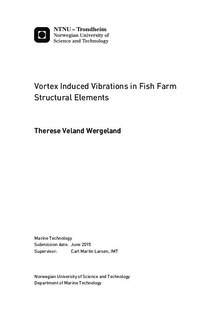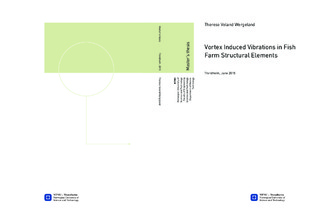| dc.description.abstract | Norway produces over 14 million meals of salmon every day. This corresponds to an annual value of close to 40 billion NOK. The world s continuous population increase will require a substantial increase in food production. The aquaculture industry in Norway has a great potential for growth. But first, several challenges related to sustainability need to be solved. One of them is to prevent escapes from cages.
Fish cages are exposed to waves and currents, and all components should be designed to survive expected load conditions. A typical fish farm structure has a sinker ring hanging beneath the net to keep it stretched and distended when exposed to environmental loads. Due to currents, vibrations due to vortex shedding on the ring can occur.
To investigate this, the sinker ring has been modeled in RIFLEX and analyzed in VIVANA for different current velocities. VIVANA is a program developed to predict vortex induced vibrations (VIV) for slender marine structures. Some adjustments and improvements on the basis of analyses done with a full cage model in AquaSim were implemented in the model boundary conditions. Due to the geometry of the structure, the magnitude of the normal component of the velocity will vary significantly over the length of the ring. This can induce a multi-mode response where several frequencies can be excited.
A range of current velocities from 0.1-1.4 m/s was investigated. The results show that there will be no vortex induced vibrations for velocities lower than 0.7 m/s. The maximum vibration and stress amplitudes occur in the part of the ring located upstream. This is related to the axial forces in the ring. Due to tension in the ropes connecting the ring to the net, compressive forces will act in the ring. The compressive forces have the largest magnitude in the upstream part of the ring. This will also affect the ring s eigenfrequencies. Compression forces lead to reduced stiffness, which gives lower eigenfrequencies.
Compared to global cage analyses in AquaSim, the RIFLEX model slightly over predicts the axial forces in the ring. However, they follow the same trend. From a simple prediction of VIV made prior to the analyses, one should expect VIV to also occur at lower velocities. Further investigation of the problem should be performed before making final conclusions regarding the survivability of the sinker ring. | |

